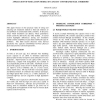Free Online Productivity Tools
i2Speak
i2Symbol
i2OCR
iTex2Img
iWeb2Print
iWeb2Shot
i2Type
iPdf2Split
iPdf2Merge
i2Bopomofo
i2Arabic
i2Style
i2Image
i2PDF
iLatex2Rtf
Sci2ools
WSC
1998
1998
Application of Simulation Models in Capacity Constrained Rail Corridors
This paper focuses on the practical value of using and selecting rail simulation models to find real solutions to real problems in constrained traffic corridors. It discusses issues which simulation can address, where quantitative results cannot be derived by any other method. A second section highlights differences among rail simulation models and the suitability of each kind to different types of problems. The third section discusses some derived parametric line capacity relationships between physical plant characteristics and train operations.
Constrained Traffic Corridors | Modeling And Simulation | Parametric Line Capacity | Rail Simulation Models | WSC 1998 |
| Added | 01 Nov 2010 |
| Updated | 01 Nov 2010 |
| Type | Conference |
| Year | 1998 |
| Where | WSC |
| Authors | Robert H. Leilich |
Comments (0)

